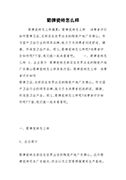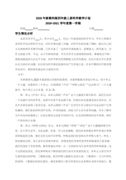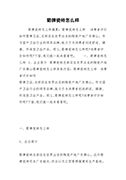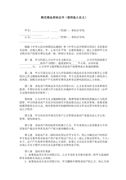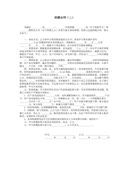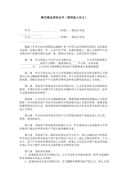《牛津小学英语》6B Unit 5 第三课时(精选12篇)六年级英语教案
《牛津小学英语》6B Unit 5 第三课时(精选12篇)
《牛津小学英语》6B Unit 5 第三课时 篇1
教学内容:a部分 listen, read and say.
教学目标:
1. 能听懂、会说和会读单词和词组jog, do well in, need help with ,do more exercise。
2. 能听得懂、会说和会读日常交际用语that’s true. well done. mike runs as fast as ben.
3. 当堂掌握四会单词strong,四会句型ben runs faster than me.
4. 能正确朗读课文,读懂课文。
教学重点:正确流利地朗读课文中的重点句型,能读懂、听懂原文。
教学难点:正确运用as…as结构
教具准备:幻灯片、录音机、小星星(well done评价)、红线、小蛋糕图片(用于玩游戏)。
教学过程:
step1 warm up
1. sing after the tape‘i wish i was taller’.
2. play a game:bingo 游戏、猜单词。
s t r o n g , l a t e, s l o w , h i g h
3. choose one word and make a sentence.选择其中一词造句。
step2 presentation
1. 学习do well in, jog, do more exercise.
①free talk:are you good at english? do you like english? are you good at pe? do you do exercise after school? what do you usually do?(引出jog to school并板书)。
i do well in pe(板书do well in)。
i hope you do more exercise. you’ll get stronger.(板书do more exercise)。
②what do they mean? ( jog, do well in , do more exercise ).
③read after the teacher.
④practise.
2. judge:判断句子中哪些句子是谈论有关运动或体育课上的话题(幻灯片出示)。
①he is good at chinese.
②she has an english book.
③a pe teacher is showing their students how to jump, run and pass balls.
④she likes having sports, so she does well in pe, too.
⑤the old man likes fishing very much, but he is not good at sports.
⑥all the students in our school have sports at half past four every afternoon.
⑦ben runs faster than me in a pe lesson.
⑧he goes home later than me.
⑨she gets up earlier than her mother.
⑩mike runs as fast as ben.
在判断的过程中强调be good at 和do(does) well in 的用法及四会句型ben runs faster than me.
3. 学习mike runs as fast as be n.渗透jim is not as strong as the other boys.
①由上一题的第10句引出mike runs as fast as ben.这一三会句型。
②what does it mean?(it指 mike runs as fast as ben.)
③who can make a sentence like this?
④who can read it?
注意变换读的形式,提高学生读句子的兴趣。
⑤talking:mike runs as fast as ben. so mike runs fast. ben runs fast, too. can you run fast? can i run fast? yes, i can run fast. because i’m strong(教师做有力量、很强壮的动作)。
i’m strong. are you strong? you are (not) as strong as me.(板书as strong as)
⑥saying.学生以as strong as 为话题谈论本班同学们的身体状况。
引出××is not as strong as the other boys.
⑦拓展:the other boys/ childen/ students/ …
4. listening exercise.
①listen to the tape.注意关键词(key words)。
②what have you heard?(汇报所听到的句子,能说多少说多少)
③read the sentences then listen again(浏览课后的判断题,带着问题再听对话录音)。
④group work.小组合作完成判断。
⑤group work.小组内合作朗读课文,找出不懂的句子和词语。
5. learning:need help with. that’s true.
通过小组内合作学习引出三会句型和词组。
补充学习:a good football /… player
step3 consolidation.
1. reporting:what have you learnt?
教师注意引导学生说出主要句型和词组。
2. play a game:help jerry get the cakes.《帮杰瑞取蛋糕》
游戏规则与过程说明:
背景是小老鼠杰瑞没有东西吃,大家帮他取蛋糕。
①教师在盒子里放上很多语言卡片(内容为课文中的主要句型,比如:jim is good at english and maths. jim is not as strong as the other boys.句子多少自定)。周边放上警戒线(比如染成红色的线)。
②要求很小心地取出语言卡片而不碰到警戒线。
③然后要求学生读出卡片上面的单词或语句,就为杰瑞获得一份蛋糕。
3. read the text together
step4 布置作业
1. group work. 小组合作,制作纸袋偶,并分角色表演课文。(具体要求见第四课时),下一节课检查并表演。
2. writing work.你知道这些短语的意思吗?
a. get stronger b. after school c. be good at
d. do well in e. the other children f. a good football player
g. play ball games
g. some of the boys h. jog to school i. do more exercise
3.完成练习册11、12页。
板书内容:
词组:jog to school, do well in, do more exercise
句子:mike runs as fast as ben. jim is not as strong as the other boys.
ben runs faster than me.
板书设计:
《牛津小学英语》6B Unit 5 第三课时 篇2
教学内容:《牛津小学英语》6b unit 6 d listen and write
教学目标:
1、能在具体情境中熟练运用所学句型what are you going to do…?及其回答i am / we’re going to…
2、熟练完成本单元d部分内容。
教学重点:熟练完成本单元d部分内容。
教学难点:
能在具体情境中熟练运用所学句型what are you going to do…?及其回答i am / we’re going to…
教具准备:录音机、磁带、课件或投影片或小黑板、图片等。
教学过程:
step1 warm up
1. sing a song
2. greetings
3. everyday english
step2 revision
1. look, read and learn和look and say.
①guessing game.
groups work.
教师课前准备一些关于周末活动的图片(可使用5b unit3 hobbies的b及本单元b部分的图片),小组内一学生选择自己最喜欢的一件,其它同学用what are you going to do…?猜他(她)将要做什么。猜对最多的同学即为优胜者,可分别加5、4、3颗星。
action.
②have a match
用what are you going to do…?及we’re going to…造句,看哪组说得最多,获胜的小组每位组员加2颗星。
2. listen, read and say.
①group work.分角色朗读并表演课文。
②action.
③look, read and complete.
it is eight thirty on ________ morning. the children ___________ have school today. gao shan and his father are going to ______ a beijing ________ ________ this afternoon. david is going to ________ the ________ tomorrow. nancy is going to _________ ________ ________ at the concert tomorrow. gao shan will come with________, _______ and_______.gao shan and david will meet at one ________ in front of the______ ________.
学生独立完成练习,集体订正,全班齐读。
step3 presentation
1. 指导学生观察图片,简要介绍对话背景,让学生了解对话主题。
2. 学生根据介绍的对话背景,了解对话主题,预测可能听到的内容,做好听的心理准备。
3. 播放全文录音,使学生养成整体接受语言材料的习惯。
4. 指导学生完成填空练习。
①在完成练习的过程中,教师要在学习方法上及时给予指导:如根据对话内容,针对所填词语设计一些问题,请学生听完后口头回答;又如指导学生做好听写记录,记下关键词……,帮助学生理解对话。
②对练习中出现的非四会单词,教师可给出单词让学生有选择地填写。
5. 教师与学生共同讨论练习答案,分析错误原因,找到解决方法。
6. 学习短语。
①学生自由画出d部分中出现的短语。
②师生共同讨论并课件或小黑板出示短语:see his parents,in new york,buy some presents,with his friends,buy some kites,at the shopping centre,near their school,watch a race,进行英汉互译练习。
7. 学习语法知识。
①介词的用法,例如in new york,with his friends,at the shopping centre,near their school中的in, with, at, near的用法。
②名词复数的用法。例如some presents,some kites,要注意some后加名词的复数;又如with his friends liu tao and wang bing,因为后面跟了liu tao和wang bing两个人,所以friend必须用复数friends。又如see his parents是父母两人,而不是父亲或母亲的parent,要讲清词义区别。
8. 全班齐读。
9. 小组内自由练读,并试着背诵。
10. 教师抽查学生的朗读和背诵情况,全班评议。
step4 consolidation
1. a task
学生就d部分的练习,重新设计填空练习,把自己认为易错的地方用红笔标注出来。
2. groups work
学生就自己设计的练习在小组内进行讨论交流,整合出一份小组的填空练习。
3. action
就小组设计的填空练习在全班范围内讨论交流。
step5 homework.
1、熟读并背诵d listen and write。
2、预习e read and number。
3、默写unit 6 的四会单词和四会句型1遍,并将错误订正。
板书内容:
is going to, parents, buy, friends, kites, shopping centre, school, dad, race
板书设计:
《牛津小学英语》6B Unit 5 第三课时 篇3
第三课时(3rd period)一、主要新授内容(new contents)let’s play-- is/are hot/cold.let’s…二、学习目标(objectives)1、通过动手制作纸牌,培养学生热爱夏天的美好情感。2、结合本课的主题――海滩,创设语言使用环境,在进行游戏的过程中,熟练运用is/are hot/cold. let’s…3、在情景中能运用所学知识来描述观察到的景物,培养学生从小善于观察的良好习惯。4、根据学生学习情况,可以在口头表达方面适当渗透cool, swimming pool,等词汇来丰富学生的语言。5、通过小组的语言练习活动,培养学生合作学习的精神。 三、教学建议1、任务前期准备阶段(pre-task preparation section)pre-task preparation是指我们要求学生运用目的语(即所学的语言)之前,呈现给学生的新语言材料。也就是我们常说的:input。在这个环节主要让学生获得对新语言材料的第一次感知。 activity 1 look and say1、教学辅助(aids)1) 纸牌2)图片 2.活动过程(process)stepscontentsmethodspurpose1questions and answerswhich season do you like?(出示四季图片) 运用图片进行问答,复习前面所学内容,激发学生的兴趣。2introduce new lessonhow do you think of summer?(将课前制作好的一组夏天纸牌出示在黑板上。)用学过的对话引出本课的新授内容,让学生通过直观的图片来了解本课的教学内容. activity 2 guessing1、教学辅助(aids)1)纸牌 2.活动过程(process)stepscontentsmethodspurpose1guessingt:in summer,it is hot. i like to eat it. it is cold. it is nice.(请学生猜一猜教师说得是那一张纸牌的图片)听力培养。。2looking and saying choose one card and describe it..…eg: it is summer. the sun is hot.the boy is thirsty.运用学生学过的对话引出本课的新授内容 2、任务中期实施阶段(while-task procedure section)while-task procedure,这是指语言技能的习得过程。其中分为机械性操练和意义性操练两部分。机械性操练可以让学生准确地模仿、复说新授的语言,让他们经过从模仿到识记的过程,使新知识由感知、理解、模仿直到储存。由于本教时新授内容有词汇也有句子而且都在两个以上,在这个教学阶段也可以设计新授知识的二次或多次导入,并根据语言训练的需要设计相应的机械性操练和意义性操练。在这种情况下,建议每项activity形式尽可能不同,时间不要长,一个活动紧接着一个活动,容易抓住学生的注意力,维持学习兴趣。 activity 1 make cards1、教学辅助(aids)1)图片2)制作材料2.活动过程(process)stepscontentsmethodspurpose1colour the cards.step 1: choose your favourite picture on the paper. step 2: cut it out.step 3: colour the card. 通过动手操作,激发学生的兴趣。 2look and say将制作的作品在小组内进行交流展示,运用所学句型进行问答练习。小组之间进行比赛,看哪个小组做的又快又好,鼓励小组成员之间互相协作。在小组分工合作中,培养学生合作的意识。 activity 2 (looking and saying)1、教学辅助(aids)1) 电脑(2b-u7-12)2) 屏幕 2.活动过程(process)stepscontentsmethodspurpose1…are cold/hot.(屏幕上依次出现一个冰激凌,两个冰激凌,三个冰激凌)the ice-cream is cold.the ice-creams are cold.引导学生仔细观察,并仿说。2pair workss1: the apple is big.s2:the apples are big.(屏幕上出现各种单数和复数图片)通过比较扎实的操练,使学生掌握句型。 activity 3 (guessing)1、教学辅助(aids)1) 电脑(2b-u7-13)2) 屏幕 2.活动过程(process)stepscontentsmethodspurpose1umbrella(屏幕上出现一副拼版,请学生仔细观察,拼图的每一块内容,屏幕上出现沙滩的一角)i see the sun there.i see the umbrella. 通过游戏,让学生在找一找,拼一拼,说一说的过程,鼓励学生大胆开口,培养学习的兴趣.2let’s sit under the umbrella.what are the boys doing?they are sitting under the umbrella.t: let’s sit under the umbrella.s: ok.s-s学生仿说。完成比较扎实的机械性操练,就进入了意义性操练阶段。意义性操练是介于机械性操练和交际性操练之间,起着承上启下的作用,把语言形式的操练转向语言内容的操练,使学生的认知逐步从知识外部特征转向知识内在的联系。由于本教时先完成词汇的新授,因此就先设计有关词汇的意义性操练活动,再导入新授句子前,完成词汇巩固。 activity 4 ( act and say )1、教学辅助(aids)1)纸牌2.活动过程(process)stepscontentsmethodspurpose1group workplease show others yourcard. talk about your card..eg: i can see two ice-creams. the ice-creams are cold.the ice-creams are nice..展示学生自己的作品,并学会介绍自己的作品,为每位学生提供开口的机会。2competition 将每位学生的作品贴在黑板上,小组内选派学生进行介绍交流,评出最佳小组。在交流过程中培养学生勇于开口的良好的习惯,在小组合作中增进同学间的友情 activity 5 (game)1、教学辅助(aids)1)电脑(2b-u7-14)2)屏幕 2.活动过程(process)stepscontentsmethodspurpose1look and memory屏幕上显示上下两排共十张扑克牌,其中有七张本单元的单词。请学生在10秒中内记住它们的位置,10秒后翻牌,牌的背面是数字1至10。在较短的时间内让学生看图记忆,发展学生的思维。2quick response.以小组为单位,一名学生挑选一张卡片说:the sun is hot. 其他学生要作出正确反应:let’s sit under the umbrella./let’s drink some water.在游戏中培养学生安静地倾听,仔细地观察,快速地表达。 activity 6 (look and say )1、教学辅助(aids)1) 学生用书 2.活动过程(process)stepscontentsmethodspurpose1look and sayopen the student’s book at page 35.we can see some cards.t: the sun is hot. let’s sit under the umbrella.通过看书本的插图,进行对话,强化所学的语言知识。 2questions and answerspair work 3、任务后期完成阶段(post-task activity section) post-task activity,这是指经过机械性操练和意义性操练,引导学生运用他们所获得的知识与技能来完成一个交际性的任务“task”,也就是语言的输出:output。学生通过前两个阶段的学习,在知识和能力上已具备综合新旧知识进行交际的能力,教师可以根据学生的实际水平设计或选用提供的活动,使学生在相应的尽可能贴近生活的语境中,正确有效使用习得语言,完成交际性的任务。由于一年级的语言量非常有限,所以可以考虑借助练习册中相应的练习设计。 activity 1(listening comprehension )1、教学辅助(aids)1) 补充材料2) 录音机 2.活动过程(process)stepscontentsmethodspurpose1listen and guess请学生将学生用书打开翻到第35页,教师根据课本图片说出谜面, 充分利用课本图片进行听力练习,指导学生掌握听力技巧。2number the picture学生猜出图片的名称,将编号写在图片旁边,请部分学生交流,检查核对。在检查核对中培养学生口头表达的能力。 activity 2(short play )1、教学辅助(aids)1)电脑(2b-u7-15)2)屏幕2.活动过程(process)stepscontentsmethodspurpose1preparation 各小组内学生讨论准备表演,表演内容是夏天海边的对话。组内分工,有的扮演家长,有的扮演孩子。 活动前期的准备活动能充分调动每位学生的积极性,发挥他们的才能,培养合作能力。2performance 表演对话,各小组进行评比通过演演评评,让学生既展示自己的风采,也学会欣赏他人。 activity 3(drawing )1、教学辅助(aids)1) 学生练习册 2.活动过程(process)stepscontentsmethodspurpose1练习册第20页circle the things you usually do in summer.练习册,看第20页上的图片,两人一组讨论交流:in summer, i like to …学生根据要求圈画培养学生看图说话的能力。2练习册第21页look,listen and colour the picture.练习册,看第21页上的图片,根据要求图色。
牛津小学英语2b unit 7 第三课时 来自98e范文网。
《牛津小学英语》6B Unit 5 第三课时 篇4
教学内容:6b第五单元第三课时。
教学目标:part a listen, read and say.
教学重点:
能听懂、会说、会读和拼写单词weather, spring, autumn, winter, hot, cold.
能听懂、会说、会读和拼写句型 what’s the weather like…?
教学难点:能听懂、会说、会读单词season, because, countryside, warm, cool, rain, rainy, sunny, windy, snowy, cloudy, rowing, snowball fights.
教具准备:单词卡片、教学挂图、录音机。
教学过程:
step 1 pre-task preparation:
1.daily report.
what’s the weather like today?
1.revision.
revise the following words: season, because, countryside, warm, cool, rain, rainy, sunny, windy, snowy, cloudy, rowing, snowball fights.
step 2 while-task procedures:
1.look and say:
look! this is new york. what’s the weather like there? say something about it.
2.listen to the tape. pay attention to the following questions:
who’s going to new york?
what does su yang want to know?
who is su yang asking for?
what’s the weather like in summer in new york?
what about autumn there?
does it often rain in spring there?
is it beautiful in spring?
listen and imitate sentence by sentence.
3.fill in the blanks:
su yang’s dad is going to____ ____ next week. he is going to work there for _____ _____. su yang wants to know about the _______ there. she is
asking ben some questions about the _________in ______ ______.
4.some explanations:
as hot as in nanjing, the best season, in the countryside, sounds great, most of the time, make snowmen, have snowball fights, colder than in nanjing, new york.
5.listen to the tape again.
listen to the tape and follow it.
step 3 post-task activity:
1.ask and answer:
what’s the weather like in spring in new york?
what’s the weather like in summer in nanjing?
what’s the best season in new york?
what clothes does dad need?
2.complete the sentences with the correct words:
in new york, there’s a lot of rain in _____. the weather in summer is as ________ as in nanjing. autumn is the best ________ in new york. it’s ________ and ________. in winter it’s _________than in nanjing. dad, you need to buy some ________clothes.
step 4 homework:
1.listen to the tape.
2.surf the internet about the weather in new york.
板书内容:
which season do you like best? i like… why? because it’s…
what’s the weather like…?
板书设计:
《牛津小学英语》6B Unit 5 第三课时 篇5
教学内容:复习第三单元,完成c部分练习。
教学目标:通过复习,操练使学生能熟练掌握与问路有关的日常交际用语。
教学重点:熟练掌握与问路有关的日常交际用语。
教学难点:熟练掌握与问路有关的日常交际用语,并能灵活运用。
教具准备: 投影片,挂图
教学过程:
step 1 warm up
1 greetings
2 sing a song. “excuse me”
step 2 revision
1 出示单词卡,复习第三单元单词。
2 创设情景,复习巩固问路交际用语。
(1)投影出示文字介绍及一幅线路图: sally is on holiday in ganyu now. she wants to go to some place ( xinhua bookshop, the post office, hualian supermarket, the bank of china , the cinema ),but she doesn’t know how to get there, and she meets you at hebing park, can you tell her how to get there?
(2)学生自由读所出示的文字,并辨认线路图。
(3)师生共同操练 how to get to xinhua bookshop,并板书重点句型。
(4)group work .小组间围绕所给信息进行问答操练。
(5)act . 指名小组表演对话。
step 3操练part c look, read and write.
1 读题,明确题意。
2 出示第一幅图,教师与一名学生示范,并讲解此种类型题目的方法.
3 学生试着完成习题.
4 交流填写情况.
5 同桌对话表演,并适当进行改编和扩充.
6 指名表演对话。
step 4 作业布置:
绘制一线路图,创设一情景,自编一组问路的对话,并写下来与同桌表演对话。
板书内容:
unit 4 review and check
can you tell me the way to…,please?
go along this street,and turn… at the …crossing.
how far is it from here?
it’s about…
.how many stops are there?
《牛津小学英语》6B Unit 5 第三课时 篇6
教学内容:a. listen, read and say(第一、二部分)
教学目标:
1、能听懂、会说、会读并会拼写单词penfriend, also。
2、能听懂、会说、会读i want to write a letter. who do you want to write to?
3、正确理解、掌握对话内容,并能朗读,表演对话。
教学重难点:正确理解,掌握对话内容,并能朗读,表演对话。
教具准备:几封信,a部分教学挂图,小黑板。
教学过程:
step 1 warm up
1、greeting.
2、revision.
①出示单词卡片,开火车读,遇到四会单词要拼写。
②学生间自由操练c部分句型。
教师可与一学生问答引出,再由学生进行操练。
③教师现场说一物品,两位学生合作,如:writing paper,请学生快速按照c部分句型编对话。
for example:
a: can i have some writing paper? b: what for?
a: i want to write a letter. b: sure. here you are.
step 2 presentation
1、因为对话较长,再将a部分分为三部分教学:第一部分为引言部分,第二部分为liu tao向妈妈要一些写信材料,准备写信,第三部分为liu tao向妈妈介绍peter的主要情况,并和妈妈讨论回信内容。
2、listen to the tape.
3、teach: a penfriend.
①教师出示自己收到的一封信,告诉学生look! here’s a letter from my penfriend,引出单词a penfriend.
②教师范读,讲解词义,告诉学生penfriend是合成词,由单词pen和单词friend组成,pen和friend都是以前学过的单词,pen-friend→penfriend。
③学生齐读a penfriend。 ④开火车拼读penfriend。
a. pen, pen, p-e-n, pen, pen.
b. friend, friend, f-r-i-e-n-d, friend, friend.
c. penfriend, penfriend, p-e-n-f-r-i-e-n-d, penfriend, penfriend.
4、 teach: also b. friend, friend,
①教师出示教学挂图,告诉学生liu tao also wants a penfriend。
②出示单词卡片also,解释词义。 ③学生分组读also。
④集体拼读also, also, a-l-s-o, also, also。
5、教师用语音直接导入yesterday afternoon, liu tao read about an english boy, peter, in the newspaper. what does liu tao want to do? let’s listen.教师组织学生听引言部分录音。
6、听完录音后,请学生回答问题,引导学生看图学习课文。
question: ①who did liu tao read about yesterday afternoon?
②what did peter want in china? ③what would liu tao like to do?
7、对话第二部分是c部分已学过的句型,可采用巩固的方式引出新内容。
教师课前将此部分的句子打乱顺序写在卡片上,现将卡片贴于黑板上,请学生四人为一组,共同讨论,看哪一组学生可以最先排列好顺序,并猜该组成员,每人教读一句。
for example:
( ) thank you.
( ) i want to write a letter.
( ) sure. here you are.
( ) what for, dear?
( ) mum, can i have some writing paper, an envelope and some stamps, please?
step 3 consolidation
1、听录音,跟读引言和对话部分。 2、师生齐读引言和对话一遍。
3、分角色朗读。 4、小组内表演对话。
5、指名表演对话。
step 4 homework
1、听a部分录音半小时,跟读两遍。 2、抄写a penfriend, also各五遍。
3、预习第二部分,请学生自编问题,下节课准备同学间交流。
板书内容:
1、课题:unit 7 a letter to a pen rend 2、单词:a penfriend, also
板书设计:
《牛津小学英语》6B Unit 5 第三课时 篇7
第三课时(3rd period)一、主要新授内容(new contents)let’s learn---water dirty wash soap towellet’s talk---i wash…with … 二、学习目标(objectives)1、在学习过程中让学生了解水的用途,了解节约用水的重要性,养成节约用水的好习惯。2、在学习过程中让学生了解生活中应该养成勤洗手的良好卫生习惯。3、学习介词with在句中的用法,能用一般现在时描述一些简单的动作:i brush my teeth with water.等,并根据学生的实际,适当拓展问句:what do you do with water?4、能够拼读单词 water, wash, towel, dirty, soap.5. 在学习过程中适当拓展一些动词词组及句型i do…with…,以达到举一反三的功能。6.运用故事进行拓展教学,让学生了解植物的生长离不开水。 三、教学建议1、任务前期准备阶段(pre-task preparation section)pre-task preparation是指我们要求学生运用目的语(即所学的语言)之前,呈现给学生的新语言材料。也就是我们常说的:input。在这个环节主要让学生获得对新语言材料的第一次感知。 activity 1(song )1、教学辅助(aids)1)录音机 2.活动过程(process)stepscontentsmethodspurpose1questions and answerst: do you brush your teeth in the morning? what do you do in the morning? 在问问答答,唱唱做做的过程中,既复习了旧知识,又在不知不觉中拓展了词汇量。 2songi jump out of bed in the morning.( 3 times )i hope it’s a very nice day.i jump out of bed and wash myself.( 3 times)i hope it’s a very nice day.( brush my teeth, comb my hair,walk to school) activity 2(opposites )1、教学辅助(aids)1)单词卡片 2.活动过程(process)stepscontentsmethodspurpose1read the opposite wordsgood—bad turn on---turn offopen---close big---small etc复习反义词为新授内容做铺垫。 2new word: dirty指着教室中的东西说:the blackboard is dirty.the desk is clean.t: what is dirty in the classroom? what is clean in the classroom?the blackboard is dirty. what shall we do ? clean the blackboard.在具体的情景中帮助学生理解单词的含义。3opposites when teacher says good i say bad.when teacher says dirty i say clean.turn on --- turn off(学生可运用上面的单词卡片自己编儿歌)运用儿歌操练所学的内容。 activity 3(game )1、教学辅助(aids)1)单词卡片 2.活动过程(process)stepscontentsmethodspurpose1group work: listen and act将一、二年级学过的所有的动词词组做成卡片分发给各组学生,让学生在小组内读一读,做做动作。帮助学生整理归纳以前所学过的语言材料。2game: who is the leader?教师将所有的单词卡片贴在黑板上,请一学生走出教室,另一学生扮演leader, 做领袖的同学需看着黑板上的卡片变换动作,其余的同学在模仿领袖的动作时还需说出英语, 出去的同学需猜出谁是领袖方可获胜。 通过游戏复习所学的语言材料 2、任务中期实施阶段(while-task procedure section)while-task procedure,这是指语言技能的习得过程。其中分为机械性操练和意义性操练两部分。机械性操练可以让学生准确地模仿、复说新授的语言,让他们经过从模仿到识记的过程,使新知识由感知、理解、模仿直到储存。由于本教时新授内容有词汇也有句子而且都在两个以上,在这个教学阶段也可以设计新授知识的二次或多次导入,并根据语言训练的需要设计相应的机械性操练和意义性操练。在这种情况下,建议每项activity形式尽可能不同,时间不要长,一个活动紧接着一个活动,容易抓住学生的注意力,维持学习兴趣。 activity 1(spelling game---snake picture )1、教学辅助(aids)1)电脑(2b-u5-11)2)屏幕3)图片 2.活动过程(process)stepscontentsmethodspurpose1new words:towel, water, soap, dirty, wash look at the picture, read and spell the words.将枯燥的单词拼写与多媒体有机结合起来,增加了趣味性。2spelling gamelook at the screen and circle the words on the snake. activity 2(game---find a pair)1、教学辅助(aids)1)电脑(2b-u5-12)2)屏幕 2.活动过程(process)stepscontentsmethodspurpose1new words:with t: i have two eyes. i see with my eyes.repetition: see with eyes在学生理解的基础上让他们自己造词组通过活动巩固新授内容。2find a pair and make a sentence给屏幕上的图片与文字互相配对并造句。i brush with water. activity 3(survey)1、教学辅助(aids)1)调查表 2.活动过程(process)stepscontentsmethodspurpose1questions and answers: t: what do you do with water?p: i … with water.在问问答答中掌握新授内容。2. group discussion discuss the use of water 通过讨论和调查,逐步渗透研究性学习的方法,让学生自主学习。3surveyp1: , what do you do with water?show the result of survey. make a list about the use of water on the blackboard. activity 4(bingo)1、教学辅助(aids)1)单词卡片2)bingo表格 2.活动过程(process)stepscontentsmethodspurpose1review the words read and spell the following words:water, dirty, wash, clean, towel, soap, soup, brush, eat, drink让学生在活动中认读单词。2. bingo 请学生将单词任意填写在表格内,教师或请一学生报单词,其余学生则在听到的单词旁做一记号,当三个单词连成一线时就叫bingo,第一个叫的同学即获胜。 activity 5(chain drills)1、教学辅助(aids) 2.活动过程(process)stepscontentsmethodspurpose1questions and answers: t: what do you do with water?p1: i … with water. what do you do with water?p2: i …with water. what do you do with water?p3:…在问问答答中掌握新授内容。2. group work 将hands, ears…替换water, 在小组内开展此活动。 通过单词的替换训练,帮助学生进一步巩固句型。 activity 6(drama)1、教学辅助(aids)1)一条毛巾 2.活动过程(process)stepscontentsmethodspurpose1drama t: what do you do with a towel?学生边模拟动作边说: i …with a towel.运用drama形式,既帮助学生掌握句型,有培养学生创造性思维。2. group work 教师为各组学生提供不同的道具:water, spoon, a picture of hands, fork etc.请各组学生在小组内完成后,上来交流,展示。 小组交流展示,拓宽语言信息量。 3、任务后期完成阶段(post-task activity section) post-task activity,这是指经过机械性操练和意义性操练,引导学生运用他们所获得的知识与技能来完成一个交际性的任务“task”,也就是语言的输出:output。学生通过前两个阶段的学习,在知识和能力上已具备综合新旧知识进行交际的能力,教师可以根据学生的实际水平设计或选用提供的活动,使学生在相应的尽可能贴近生活的语境中,正确有效使用习得语言,完成交际性的任务。 activity 1(listening and speaking)1、教学辅助(aids)1)电脑 (2b-u5-13)2)屏幕 3)录音机 课文磁带 2.活动过程(process)stepscontentsmethodspurpose1listening listen and read after the tape学生在模仿原版的基础上,自编对话,使学生的语言与思维两系并进。2dubbing将屏幕上的字去掉,让学生自己配音。 3role play两人一组,可模仿说话,也可自编对话。 activity 2(listening)1、教学辅助(aids)1)录音机 磁带2)学生练习册 p.14 2.活动过程(process)stepscontentsmethodspurpose1speaking look at the picture and make some sentences.i’m . i wash my hands with water.看图说话,培养学生运用语言的能力。2listen and matchdo exercises on p.14 在听力过程中让学生掌握基本的听力技巧。3checking listen and check the answer. activity 3(story)1、教学辅助(aids)1)电脑(2b-u5-14)2)屏幕 2.活动过程(process)stepscontentsmethodspurpose1listen to a story. t: i’m a seed. i’m thirsty. “water, i need water. look, that’s water. yummy, yummy”. i like the sun. i need sunshine. sun and water can make me grow. i grow and grow. i grow very high. i grow very big. look, i’m a sunflower, a beautiful sunflower.通过故事的形式,让学生了解植物的生长离不开阳光和水。将语言学习与其他学科有机整合起来。2questions and answerst: what do you see on the screen? how is the seed? does he like sunshine and water? what does he become at last?问问答答帮助学生理解故事内容。3retell the story请学生扮演种子上台表演。 让学生上台,演一演,说一说,在语言学习的同时,培养学生的自信心。 activity 4(poem)1、教学辅助(aids)1)电脑(2b-u5-15)2)屏幕 2.活动过程(process)stepscontentsmethodspurpose1listening listen to a poem:sunflower in the sun, growing very high.sunflower in the sun, growing very high.sun and water you need to make you grow from a seed.a sunflower grows higher and higher..a sunflower grows bigger and bigger.sunflowers love the sun. sunflowers love the water.but what do they do at night?please tell me, what do they do atnight. 运用小诗的形式,让学生进一步感知语言。2read the poem.read after the teacher. 上述两项活动,主要是针对学有余力的学生,教师可根据本班学生的实际情况,选择适当的活动。
《牛津小学英语》6B Unit 5 第三课时 篇8
【教学设计(teaching design)】unit 6 eating and drinking 第三课时(3rd period)一、主要新授内容(new contents)let’s talk— i’m thirsty. i want some juice. i’m hungry. i want some bread. four spoons? yes, please. a knife? no, thanks. 二、学习目标(objectives)1、通过对话的教学,培养学生热爱劳动的美好情感。2、结合本课的主题------从小养成爱劳动的好习惯,创设语言使用环境,让学生灵活运用所学知识进行交际。3、在教学过程中能认真听,培养学生从小善于模仿的良好习惯。4、在教学过程中,在口头表达方面渗透yes, please. / no, thanks.等句型来丰富学生的语言,培养学生学习良好的礼貌用语。5、通过小组的语言练习活动,培养学生合作学习的精神。 三、教学建议1、任务前期准备阶段(pre-task preparation section)pre-task preparation是指我们要求学生运用目的语(即所学的语言)之前,呈现给学生的新语言材料。也就是我们常说的:input。在这个环节主要让学生获得对新语言材料的第一次感知。 activity 1 look and say1、教学辅助(aids)1)电脑(2b-u6-12)2)屏幕 2.活动过程(process)
stepscontentsmethodspurpose1look and listen媒体中出现课文中的图片,请小朋友仔细听录音。由媒体引出课文,激发学生的兴趣。2introduce new lesson在听的基础上请学生模仿课文的语音语调。在仔细听的基础上模仿,培养学生听与模仿的能力。
activity 2 guessing1、教学辅助(aids)1)单词卡片2)录音 2.活动过程(process)
stepscontentsmethodspurpose1learn: thirsty /hungry结合小朋看图片,教师通过提问:what does he/she feel?来教授新单词thirsty/hungry通过图片的画面吸引学生的注意力,通过不断地问答,让学生运用新单词开口表达。2listen and repeat听录音跟读对话,注意语音语调的模仿。运用学生学过的对话引出本课的新授内容
2、任务中期实施阶段(while-task procedure section)while-task procedure,这是指语言技能的习得过程。其中分为机械性操练和意义性操练两部分。机械性操练可以让学生准确地模仿、复说新授的语言,让他们经过从模仿到识记的过程,使新知识由感知、理解、模仿直到储存。由于本教时新授内容有词汇也有句子而且都在两个以上,在这个教学阶段也可以设计新授知识的二次或多次导入,并根据语言训练的需要设计相应的机械性操练和意义性操练。在这种情况下,建议每项activity形式尽可能不同,时间不要长,一个活动紧接着一个活动,容易抓住学生的注意力,维持学习兴趣。 activity 1 1、教学辅助(aids)1)图片2)单词卡片3)句型卡片 2.活动过程(process)
stepscontentsmethodspurpose1review: need, like want在学习want的基础上复习like, need,并通过不同的句型:what do you want?/do you want…?what do you need?/do you need…?what do you like?/do you like…?通过句型及单词的操练,巩固旧知,并且与新授有效地结合在一起。2look and say运用所学句型进行问答练习。小组之间进行比赛,看哪个小组做的又快又好,鼓励小组成员之间互相协作。在小组分工合作中,培养学生合作的意识。
activity 2 1、教学辅助(aids)1)句型卡片2)实物3)录音4)图片 2.活动过程(process)
stepscontentsmethodspurpose1new sentence pattern: i’d like…在学习i want…的基础上适当拓展新句型i’d like…引导学生仔细观察,并比较两者的异与同。2practice 按照教师的要求,运用不同的句型进行替换操练,同学之间可以相互结对子,老师也可选取几组进行反馈。用替换练习的形式来巩固学生学过的内容,激发学生的兴趣。
3、任务后期完成阶段(post-task activity section) post-task activity,这是指经过机械性操练和意义性操练,引导学生运用他们所获得的知识与技能来完成一个交际性的任务“task”,也就是语言的输出:output。学生通过前两个阶段的学习,在知识和能力上已具备综合新旧知识进行交际的能力,教师可以根据学生的实际水平设计或选用提供的活动,使学生在相应的尽可能贴近生活的语境中,正确有效使用习得语言,完成交际性的任务。由于一年级的语言量非常有限,所以可以考虑借助练习册中相应的练习设计。activity 1(listening comprehension )1、教学辅助(aids)1)课本2)录音 2.活动过程(process)
stepscontentsmethodspurpose1listen and read请学生听录音模仿跟读,注意语音语调。充分利用课本图片进行听说练习,指导学生掌握听说技巧。2say and act请学生不听录音,自己结对进行操练。并全班反馈。在反馈中培养学生口头表达的能力。
activity 2( look and find )1、教学辅助(aids)1)学生练习册2)录音 2.活动过程(process)
stepscontentsmethodspurpose1do the exercise在教师的指导下听录音完成相应的练习。通过听力及笔头练习巩固所学内容。2check教师与学生共同进行核对。在核对过程中,通过互帮互助,让每个学生得到发展。
附件:媒体制作说明1. 2b-u6-12: 出现p28的画面
《牛津小学英语》6B Unit 5 第三课时 篇9
第三课时(3rd period)一、主要新授内容(new contents)let’s act— get up, have lunch go to bed 二、学习目标(objectives)1、通过表演may一天的日常生活起居,培养学生良好的时间观念和生活习惯2、结合本课的主题―time,创设语言使用环境,在may 一天的生活起居过程中,熟练运用what time is it?及其答句it’s ___.o’clock.3、在情景中能运用所学知识来描述观察到的时间和景物,培养学生从小善于观察的良好习惯。4、根据学生学习情况,可以在口头表达方面适当渗透 wake up, lazy, ready等词汇来丰富学生的语言。5、通过小组的语言练习活动,培养学生合作学习的精神。 三、教学建议1、任务前期准备阶段(pre-task preparation section)pre-task preparation是指我们要求学生运用目的语(即所学的语言)之前,呈现给学生的新语言材料。也就是我们常说的:input。在这个环节主要让学生获得对新语言材料的第一次感知。activity 1 look and say1、教学辅助(aids)1) 录音机2)图片2.活动过程(process)stepscontentsmethodspurpose1questions and answerslisten. what can you here? what time is it? 运用录音机和图片先听再进行问答,复习前面所学内容,激发学生的兴趣。2introduce new lesson.input: it’s eight o’clock in the morning now. but may is still sleeping now. she will be late for school. so her mother wakes her up: 引出新授内容。 并引出新授内容 activity 2 ( look, listen and answer )1、教学辅助(aids)1)电脑(2b-u8-10)2)屏幕 2.活动过程(process)stepscontentsmethodspurpose1story把may一天的生活起居制成flesh, 配上录音变成一个小故事,让学生边看flesh边听录音 ,初步感知新授内容……通过多媒体flesh画面吸引学生的注意力。 2questions and answerwhat time can you hear in this story?运用学生学过的对话引出本课的新授内容 activity 3 (guessing)1、教学辅助(aids)1) 录音机2)屏幕 2.活动过程(process)stepscontentsmethodspurpose1listen& answersit’s seven o’clock in the morning. i’m not brush my teeth. i’m not wash my face. i close my eyes. i’m in the bed. what do i do?((sleep)运用猜谜游戏引出新单词,丰富学生的语言。2guessingwhat time is it?is it lunch time ?is it time for bed?运用学生学过的知识引出本课的新授内容,激发学生的兴趣2、任务中期实施阶段(while-task procedure section)while-task procedure,这是指语言技能的习得过程。其中分为机械性操练和意义性操练两部分。机械性操练可以让学生准确地模仿、复说新授的语言,让他们经过从模仿到识记的过程,使新知识由感知、理解、模仿直到储存。由于本教时新授内容有词汇也有句子而且都在两个以上,在这个教学阶段也可以设计新授知识的二次或多次导入,并根据语言训练的需要设计相应的机械性操练和意义性操练。在这种情况下,建议每项activity形式尽可能不同,时间不要长,一个活动紧接着一个活动,容易抓住学生的注意力,维持学习兴趣。 activity 1 repeating1、教学辅助(aids)1)电脑 (2b-u8-11)2)屏幕2.活动过程(process)stepscontentsmethodspurpose1get up. 由look and say引出新授内容,并操练get up, may 通过演一演,说一说,激发学生的兴趣。 2look and sayit’s eight o’clock in the morning. may is still sleeping now. who can help me? (s1, s2, ...一个二个,一组,二组,全班上来帮忙一起叫醒她)操练 wake up, wake up, may.get up, get up, get up.声音由轻到响,有个人到全体,结合画面,让枯燥的机械练习变得有趣味。 activity 2 ( doing a puzzle )1、教学辅助(aids)1) 电脑(2b-u8-12)2) 屏幕2.活动过程(process)stepscontentsmethodspurpose1look and sayhave lunch. (屏幕上出现一副拼版,请学生仔细观察拼图的每一块内容,猜猜拼出来会是什么)1.what can you see? i see a fish/boy/... here.i see a bowl of rice /sofa/ table/chairs... there.i see a clock / watch.2. what time is it? it’s eleven thirty.3. what do they do?引出: have lunch引导学生仔细观察,并用学过的知识进行表达。“have lunch.” 在第一课时已学,因而本教时重点放在描述。.2do a puzzle(group work)1. let’s do a puzzle together.put no. ___ in the middle.( on the left/ on the right..)2.describe. it’s ___ o’clock in the __lunch is ready. let’s have lunch.用猜一猜,拼一拼的形式来巩固学生学过的内容,激发学生的兴趣。 activity 3 (game)1、教学辅助(aids)1)句子卡片2.活动过程(process)stepscontentsmethodspurpose1find your friend(group work)教师分发材料,每人得到教师已经写好的一句句子,请学生根据自己的材料去寻找另一半,边找边说:it’s nine o’clock in the morning/ evening. i get up/ go to bed. 等,综合巩固前三个环节内容。通过“寻找另一半”的游戏,让学生在找一找,拼一拼,读一读的过程,鼓励学生大胆开口,培养语言学习的兴趣。2look and read. 1. 当学生找到自己的另一半时,将两句合起来,以期朗读:it’s ___ o’clock in the ___ .i ____. 2.rhyme:go to bed, tom,go to bed, tom,tired or not, tom,go to bed, tom. 完成比较扎实的机械性操练,就进入了意义性操练阶段。意义性操练是介于机械性操练和交际性操练之间,起着承上启下的作用,把语言形式的操练转向语言内容的操练,使学生的认知逐步从知识外部特征转向知识内在的联系。由于本教时是短句,且没有新单词,因此就设计有关短句的意义性操练活动和表演。 activity 4 (look and say )1、教学辅助(aids)1) 书 2.活动过程(process)stepscontentsmethodspurpose1look and sayopen the book at page 37.what do you see?what time is it?通过看书本的插图,进行对话,强化所学的语言知识。 2questions and answerspair workactivity 5 (listen and memory)1、教学辅助(aids)1)电脑(2b-u8-13)2)屏幕 2.活动过程(process)stepscontentsmethodspurpose1look, listen and memory屏幕上显示与课文插图时间不同的3只钟面,但事先不提示学生,请学生看图听录音,然后说出听到的时间。what time does sam get up? get up --- 7:00 have lunch--- 12:15 go to bed. ---- 9:30在较短的时间内让学生看图听录音记忆,发展学生的思维。2have a match.(group work) 以小组为单位挑选一幅说说改编后的3幅图,说对一句得一颗星,展开小组竞赛。在游戏中培养学生倾听,观察和快速地表达。activity 6 (look and say )1、教学辅助(aids)2) 书 2.活动过程(process)stepscontentsmethodspurpose1look and sayopen the book at page 37.what do you see?what time is it?通过看书本的插图,进行对话,强化所学的语言知识。 2questions and answerspair work 3、任务后期完成阶段(post-task activity section) post-task activity,这是指经过机械性操练和意义性操练,引导学生运用他们所获得的知识与技能来完成一个交际性的任务“task”,也就是语言的输出:output。学生通过前两个阶段的学习,在知识和能力上已具备综合新旧知识进行交际的能力,教师可以根据学生的实际水平设计或选用提供的活动,使学生在相应的尽可能贴近生活的语境中,正确有效使用习得语言,完成交际性的任务。由于二年级的语言量非常有限,所以可以考虑借助练习册中相应的练习设计。 activity 1(listening comprehension )1、教学辅助(aids)1) 补充材料2) 录音机3)投影仪 2.活动过程(process)stepscontentsmethodspurpose1listen and guess请学生将学生用书打开翻到第37页,教师根据课本图片改变时间,听录音,将may现在的作息时间表写在图的旁边。充分利用课本图片进行听力练习,指导学生掌握听力技巧。2check学生写好更改的时间后,请一请1-2位学生交流,检查核对。在检查核对中培养学生口头表达的能力。activity 2(read )1、教学辅助(aids)1)图片2)投影仪2.活动过程(process)stepscontentsmethodspurpose1look and say屏幕上出课本上的3幅图,请学生说一说,一起把它补充得更详细,完整。(每幅图2-3句, 不超过4句)通过看图回答问题和描述,既发展学生的口头表达能力,也培养学生良好的观察的习惯。2read朗读训练重视朗读能力的培养,让每个学生得到发展。 activity 3(short play )1、教学辅助(aids)1)屏幕 2.活动过程(process)stepscontentsmethodspurpose1preparation 各小组内学生讨论准备表演,表演内容是妈妈与may的对话。组内分工,有准备道具,又有扮演道具或背景等。活动前期的准备活动能充分调动每位学生的积极性,发挥他们的才能,培养合作能力。2performance 在学生自己准备的小舞台上,为大家表演对话,各小组进行评比(分为最佳台词,最佳表演,最佳背景,最佳制作等)通过演演评评,让学生既展示自己的风采,也学会欣赏他人。
《牛津小学英语》6B Unit 5 第三课时 篇10
教学内容:c. work in pairs d. listen and write
教学目的:
1.能熟练掌握句型“who’s taller than david? whose schoolbag is heavier, yours or mine?”并能灵活进行替换练习。
2.能听懂所听内容,提取有用信息,并用完成填空的方式重构信息。
3.在激发学生兴趣的基础上提高学生的听力。
教学重点:
1.根据提供的单词灵活替换句型。
2.根据所听内容完成信息重构。
教学难点:根据所听内容完成信息重构。
教具准备:录音机、磁带、图片等。
教学过程:
step 1 warm up
1.greetings
2. sing a song: i wish i was taller
3. free talk.
围绕本单元的b部分单词及句型“who’s…than….? whose…than…? as…as…”等句型结合学生实际与生进行闲谈。
step 2 revision
1. listen and repeat.(a部分内容)
2. look and read.
①出示b部分图片指学生读。
②小组竞赛方式,复习形容词及其比较级的读法。
3.look and write.
根据出示的单词,写出它们的比较级。如:old-older
4. look and say
①出示图片,引导生用“who’s…than…? whose…is…”进行对话.如:who’s taller than david? gao shan is. whose schoolbag is heavier, yours or mine? yours is, i think.
②出示单词,引导生替换。
old, young, long, tall, short, fat…
step 3 presentation
1. look and say
出示图片,指导讨论图片内容。
如: how many people are there in the photo? who are they? who’s older, the man in black or in blue? who’s younger, the woman in green or in purple?
2. listen to the tape.
指导生边听边记录关键词
3. listen and repeat
4. listen and complete
5. listen and check
6. read the sentences.
step 4 homework
1. listen and read part a.
2.选择完成c部分的替换练习,并与同位操练对话。
板书内容:
句型: who’s taller than david? gao shan is.
whose schoolbag is heavier, yours or mine?
yours is. i think.
图片(c部分.d部分)
板书设计:
教后笔记:
《牛津小学英语》6B Unit 5 第三课时 篇11
教学内容:《牛津小学英语》6b unit 3 asking the way a listen, read and say
教学目标:
1. 能正确地理解、掌握对话内容,并能初步朗读和表演对话。
2. 能正确地听、说、读词汇:miss, kilometre, away, only, city, road, far。
3. 掌握句型how far is it from here? it’s about a kilometre away。
教学重点:能正确理解、掌握对话内容,并能朗读、初步表演对话。
教学难点:能比较流畅地朗读对话,并能在掌握对话的基础上运用本课语言进行“问路”的对话交流。
教具准备:本单元的单词卡片、a部分挂图、磁带、录音机。
教学过程:
step1 warm up
1. listen to the song: excuse me
2. listen and do:
show me your left hand. / touch your right leg with your right hand. / stand up. / turn right. / turn left…
3. chant: where’s the bookshop?
4. look and say:快速出示单词卡,说出卡片上的单词,并拼读。
step2 presentation and practice
1. 出示本地区交通图,师生对话,引入本课话题。
t:mr smith is new here. he wants to visit hebing park. but he does not know the way. who can tell him how far is it from here? how to get there?
s:it’s about three kilometre away.
he can take bus no.4
t:how many stops are there?
s:there are two stops.
2. 板书对话中出现的新授句型并讲解,领读。
3. 分段呈现a部分内容,引导学生学习。
①学习第一段背景介绍。
a. 出示问题:
where does mr smith come from?
where is he living now?
what does he want to do?
does he know the way?
what is he doing now?
b. 听录音回答问题。
c. 跟读背景介绍部分的内容。
d. 齐读、个别读。
②学习课文对话的第一部分(从开始至页底),就对话场景提问,引导学生进入对话情景。
a. can you tell me the way to the history museum?
b. how far is it from here?
c. how many stops are there?
(教学程序同背景介绍)
③学习对话教学的第二部分。
本部分重点围绕询问车站在哪里。可通过听录音请学生回答where’s the bus stop?引导学生学习,学习方法同上。
注意帮助学生理解every five minutes的意思,如出示一个当地某公交车的发车时间表等。
④学习对话教学的第三部分。(从i want to go to the city post office, too.至结尾。)
就对话提出问题:
a. where else does mr smith want to go?
b. where is it?
c. how can he get there?
重点训练句型:you can take bus…and get off at the…stop.
4. 学生整体听读课文,利用挂图进一步理解对话内容。
5. 强调重点句型,分段表演对话朗读。
6. 在学生充分理解课文的基础上,指导学生完成对话后的练习。
step3 consolidation
教师在黑板上画交通图,根据图意同位看图编一段小对话“asking the way”并试着表演。
step4 homework
1. 听录音,用正确的语音语调朗读本课对话。
2. 同位练习表演问路。
板书内容:unit 3 asking the way
questions:1. can you tell me the way to the history museum?
2. how far is it from here?
3. how many stops are there?
4. where’s the bus stop?
5. where else does mr smith want to go?
6. where is it?
7. how can he get there?
板书设计:
《牛津小学英语》6B Unit 5 第三课时 篇12
教材依据:《牛津小学英语》6a unit 7 at christmas a部分。
教学目标:
1. 学生能听懂、会说、会读和会拼写单词:watch, teapot, wallet, hairdryer, calculator, skateboard, mine, yours, his, hers, theirs.
2. 学生能听懂、会说、会读和会写句型:whose … is it? whose … are they?及其回答。
3. 学生初步掌握a部分的对话。
教学重点:b部分单词和句型
whose … is it? whose … are they?及其回答。
教学难点:名词性物主代词的用法。
课前准备:多媒体课件。
教学过程:
step 1. greetings. (会话导入)
1. t: hello, boys and girls. my name is vicky, your name please? s: my name is …
t: nice to meet you. s: nice to meet you, too.
t: how are you? s: fine, thank you. and you? t: i’m fine, too.
2. t: i want to make friends with you. let’s sing a song <make new friends>.
这一步骤主要是通过询问学生姓名,互问身体情况等与学生拉近距离,并且通过演唱歌曲<make new friends>让学生感觉到老师和他们的距离很近,同时也是让他们做好上英语课的准备,调动学生说英语的积极性。
step 2. learn the new words. (新授b部分单词)
1. show a calendar. t: today is the 25th of december. it’s christmas day.
show the pictures and the words ‘christmas, christmas day, merry christmas, christmas tree.’
2. t: on christmas day, people always sing <ring, ring, ring the bells>
listen to the song.
让学生在特定的情境中展开对话而不是进行机械的无意义的对话,这样比较符合小学生的学习特点,因此我采用圣诞节这一情境带出圣诞快乐、圣诞树等词语。并且让学生听一听人们通常在圣诞节这一天唱的歌曲来感受圣诞节的气氛,同时也是为下面用圣诞礼物引出新单词做铺垫。
3. t: merry christmas! i have some christmas presents. please look at the picture.
draw a watch on the blackboard.
t: what is it? s: it’s a watch.
write the word on the blackboard, students read and spell the word.
4. draw a teapot on the blackboard.
t: it’s a teapot.
write the word ‘teapot’ on the blackboard, students read the word after the teacher.
5. draw a wallet on the blackboard.
t: it’s a wallet.
write the word ‘wallet’ on the blackboard, students read the word after the teacher.
6. draw a hairdryer on the blackboard.
t: it’s a hairdryer.
write the word ‘hairdryer’ on the blackboard, students read the word after the teacher.
7. draw a calculator on the blackboard.
t: it’s a calculator.
write the word ‘calculator’ on the blackboard, students read the word after the teacher.
8. draw a skateboard on the blackboard.
t: it’s a skateboard.
write the word ‘skateboard’ on the blackboard, students read the word after the teacher.
9. read all the words together.
传统的出示图片然后新授单词对学生们来说已经没有了新鲜感,因此在这一步骤中我并没有这样做,而是用简笔画将这些东西画在黑板上然后再学习。因为 watch这个单词学生是学过的,学生比较容易掌握,因此我就让学生自己说出这张图片代表的单词。接着我就边画边说出今天要新授的单词,学生看得认真也听得认真。
10. play a game. (做游戏)
t: i will give you 30 seconds. you can make phrases using the new words. let’s see how many you can make.
make some examples. students work in groups.
这是个以比赛形式进行的游戏,学生在掌握了今天新授的单词后一个接一个的用这些单词来组词,组词最多的小组获胜并能获得老师的奖品。这一步骤不仅是巩固今天新授的单词也是复习了以前学过的一些知识,学生的积极性也非常高。
step 3. learn the new sentences. (学习新句型)
1. show a picture of a teapot. t: who is it from? 很快的闪动一下helen的图片。
s: it’s from helen.
show a picture of a hairdryer. t: who is it from? s: it’s from yang ling.
show a picture of a skateboard. t: who is it from? s: it’s from mike.
2. show a picture of two wallets. t: who are they from? 很快的闪动一下su yang and su hai的图片。s: they are from su hai and su yang.
show a picture of a ruler and a pencil. t: who are they from? s: they are from ben.
这个句型以前有接触过并且对学生来说比较简单,因此我没有要求学生跟读然后再操练,这样学生就不会觉得老师在教一些自己会的东西。同时出现的人的图片非常短暂,学生必须高度集中注意力才能看清楚,这就充分能发挥学生的主体作用。
3. t: oh, the ruler is from ben. it’s mine.
show the new word ‘mine’. students read and spell the word.
show the sentence structure: whose is it? it’s mine.
ask and answer using their things.
4. take two or three things of one student. t: whose are they? s: they are mine. t: oh, they are yours.
show the new word ‘yours’, read and spell the word.
5. look at the picture of a calculator. ask some students to read the word. listen and repeat the word. t: whose is it?
students listen and learn the new word ‘his’.
show the sentence and read: it’s his.
look at the picture of a magazine. listen and repeat the word. t: whose is it?
students listen and learn the new word ‘hers’.
read the sentence: it’s hers.
6. look at the picture of two skateboards. ask some students to read the word. listen and repeat the word. t: whose are they?
students listen and learn the new word ‘ours’.
t: they are theirs.
show the word. read and spell the word.
对于小学生来说名词性物主代词是个难点,我使用了学生课桌上的东西来教学。如拿出自己的一本书说:it’s mine.(这是我的。)拿起学生课桌上的两样或三样东西,提问:whose
are they?学生自然会回答:they are mine. 这时就顺势说出they are yours.并教学新单词yours。这样的方法学生很容易就理解了这些单词和句子的意思,同桌操练起来也非常方便。
7. let’s chant.(有节奏的朗读)
watch, watch, it’s mine, mine. skateboard, skateboard, it’s yours, yours.
hairdryer, hairdryer, it’s his, his. calculator, calculator, it’s hers, hers.
wallets, wallets, they’re ours, ours. teapots, teapots, they’re theirs, theirs.
将名词性物主代词教学完后我设计了这样一个chant,让学生通过有节奏的朗读来巩固所学的单词。
step 4. listen, read and say. (学习a部分课文)
1. t: the cds are su yang’s. they’re her christmas presents. let’s go back to jim’s grandpa’s house. listen to the tape and tell me whose are these presents.
students listen to the tape and do the exercise.
check the answers..
2. read after the tape.
read part a together. work in pairs and act.
这一步骤是对上面教学的单词和句型的一个全面的学习。首先我要求学生听录音完成书本上的一个比较简单的连线题,然后再根据这一主线来跟读课文并分角色朗读。虽然课文很长但学生基本都能掌握,因此学习起来很有信心,效果也比较好。
step 5. say goodbye.(结束本课并布置课堂作业)
1. t: christmas is coming. i wish you a merry christmas. let’s sing a song <we wish you a merry christmas>.
课上到这里学生和老师都比较疲倦了,因此我设计了演唱<we wish you a merry christmas>这首歌,让学生和老师一起唱起来,在轻松愉快的氛围中结束本课。
2. assign the class work: make a christmas card for your teachers.


